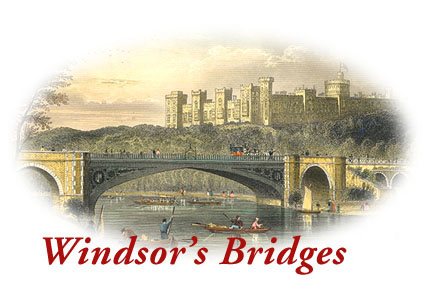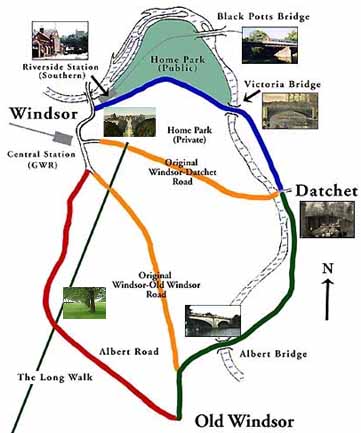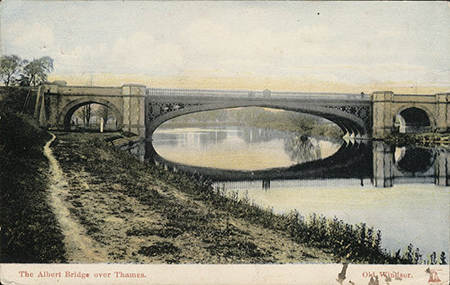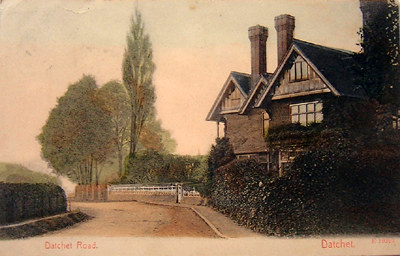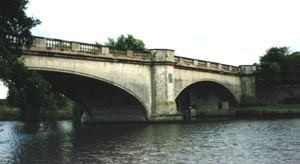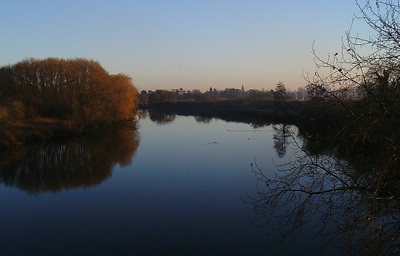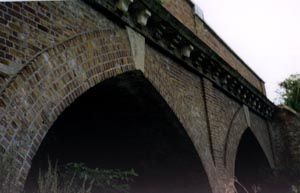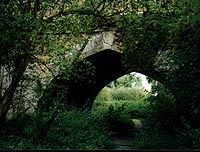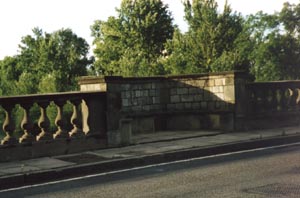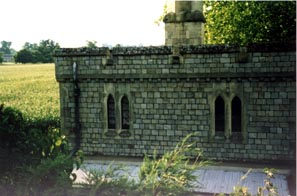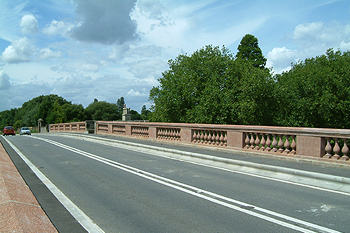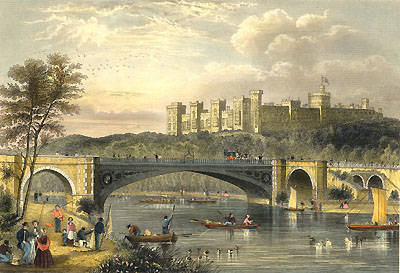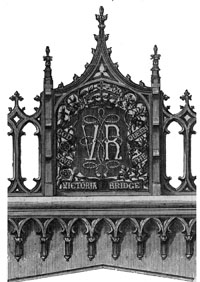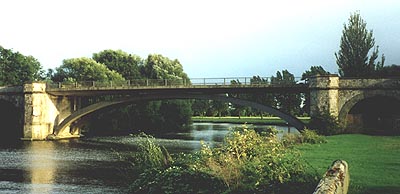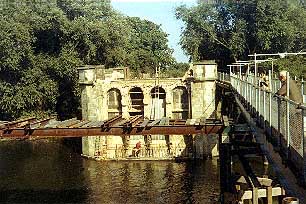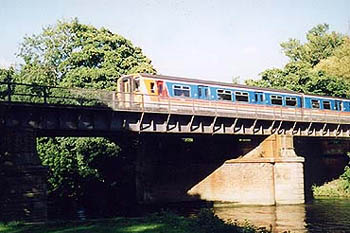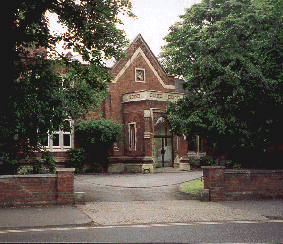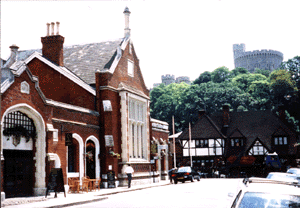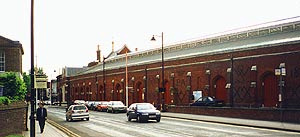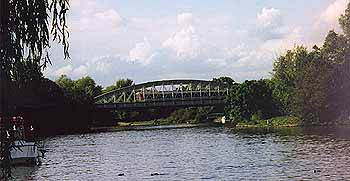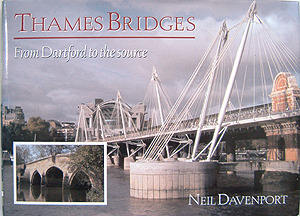Introduction
The only bridge across
the Thames in this area for hundreds of years was at the point
where Windsor Bridge now stands although a ferry also operated
across the river at Datchet. It is only comparatively recently
that other bridges have been built nearby. One of the earliest
alternative bridges was built downstream at Datchet providing
an east-west link on the road between London and Windsor and
replacing the ferry earlier. The only other option would have
been to 'ford' the river but this would not always have been
possible, especially in times of flood.
The Datchet Ferry
was illustrated [see below] in 1686. At that time the road from
Windsor to the east passed through what we now know as the private
area of the Castle grounds and crossed into the High Street at
Datchet.
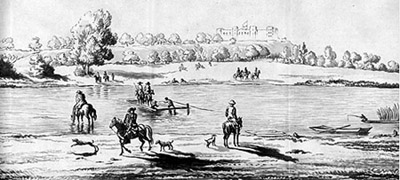 Datchet Mead and
Datchet Ferry, A.D. 1686
Datchet Mead and
Datchet Ferry, A.D. 1686
(Tighe and
Davis, 'Annals of Windsor', Vol. 2, p 492)
In 1706 Queen Anne erected
a wooden bridge at this spot and discontinued the ferry. The
bridge was for the use of the public and was at all times free
of toll much to the concern of Windsor's Corporation who lost
revenue from their toll bridge as a result, but were recompensed
by The Treasury. In 1734 the bridge was repaired at a cost of
£800, paid for the the Crown.
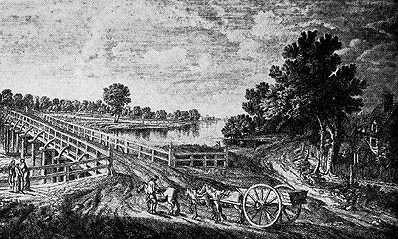 Datchet Bridge in the 1750s which
Queen Anne had built in 1706. (William Oram)
Datchet Bridge in the 1750s which
Queen Anne had built in 1706. (William Oram)
Around 1770 the bridge
was rebuilt as ten wooden arches resting on stone piers, but
this was short-lived, one section collapsing in 1794 during heavy
floods. The ferry was therefore reinstated once more at the expense
of George III.
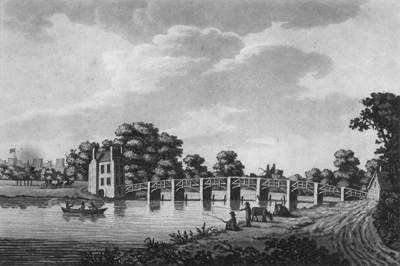 A view upstream
of the 1770 bridge 'published for S Ireland in May 1799'
A view upstream
of the 1770 bridge 'published for S Ireland in May 1799'
but by that date one of the arches had collapsed.
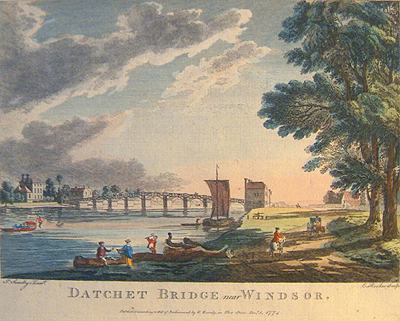
The 1770 bridge
looking downstream by Edward Rooker after a painting by Paul
Sandby in 1774.
Two paintings exist showing the piers of
the ruined bridge, one by J Hakewill in his 'Views of the Neighbourhood
of Windsor', London, 1820. p.31. According to Tighe and Davis,
'Annals of Windsor' p. 494, this dates from 1810 although other
references date it from 1795.
The other image is an engraving by William Havell.
The Havell brothers published c. 1818 the volume "Picturesque
Views of the River Thames" which features scenes from along
the river. These were coloured by the brothers in aquatint from
drawings by William Havell. In his engraving of Datchet Ferry,
the ferry is seen being drawn by rope across the river and carrying
a horse, cart and several foot passengers. The Crown and Angel
Inn is shown on the Windsor bank plus the ruined piers of the
bridge to the right, upstream. The picture is reproduced below
and pre-dates the 1812 bridge reconstruction.
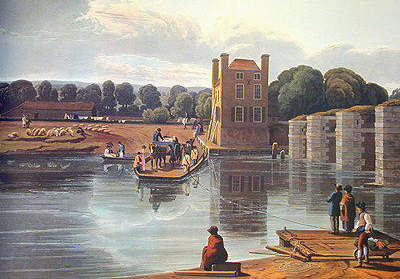
Datchet Ferry from the Havell brothers'
"Picturesque Views of the River Thames" published c.1818
but showing the bridge and ferry before 1812.
Following the collapse of the 1770 bridge,
an argument ensued between Buckinghamshire and Berkshire as to
who should pay for its replacement. By this time the king, George
III, was determined not to have to pay for yet another bridge,
being of the view that it was now the responsibility of Berkshire
and Buckinghamshire whose county boundaries met in the middle
of the river, a fact that was to lead to trouble in the future.
Mr John Richards, rector of Datchet and a lawyer,
set out in 1801 to force the two counties to erect the new crossing.
By 1809 a King's Bench hearing required that both counties should
contribute half the cost of rebuilding, a total of £2,375
each.
By January 1812 the new bridge had been constructed
on the old stone piers. The lack of income from tolls had restricted
the options during the rebuilding, but its completion was met
with great celebration in Datchet at the time, illustrating just
how important the river crossing was to local trade.
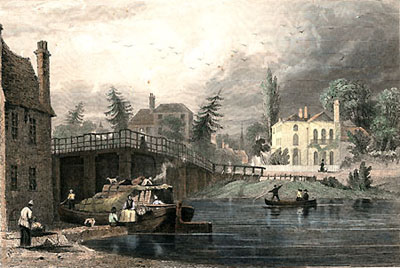 Datchet Bridge
from 1812 to 1836
Datchet Bridge
from 1812 to 1836
An engraving painted by Tombleson and engraved by T Harris.
This view is from the Berkshire side, looking towards Datchet
village and was first published around 1820 in black and white
with the above tinted version being published in 1840.
It was not long however before the bridge
was causing trouble again. By 1834 further repairs and restoration
were required on the Datchet (Buckinghamshire) side for which
Berkshire refused to accept any financial responsibility, until
it was found that Berkshire's half of the bridge was nearing
collapse also. When Buckinghamshire's side actually collapsed,
Berkshire wanted to totally rebuild the bridge in iron (as had
been successfully constructed at Windsor ten years earlier).
But Buckinghamshire refused and so they went their own ways,
Berkshire rebuilding in iron, Bucks in wood! This new bridge was described as "a hideous
monstrosity", and showed the lack of compromise between
the two counties where claim and counter-claim had lasted for
almost 20 years. At its centre Berkshire had built a cantilever
that did not rely on structural support from the Buckinghamshire
side. Two pictures are known to exist of this 'hideous monstrosity',
one by J Bannister, from 1837 viewed from upstream on the Windsor
bank, and a second, reproduced below, dating from 1847.
In a directory by Kelly and published by The Post
Office in 1847, the entry for Datchet features the following
description of the bridge.
| Datchet is separated from Windsor by the river
Thames, over which is a very singular bridge; one half of it
is kept in repair by the county of Bucks and the other half by
Berks. The former has a wooden railing and the latter an iron
one, suspended by chains, but neither the Bucks nor Berks sides
touch each other. The view from it is very beautiful commanding
a magnificent extent of scenery Windsor castle, Eton college,
the winding of the Thames, and a great portion of the royal park. |
The bridge would finally
be completely removed as a result of The Windsor Improvement
Act of 1848 which resulted in the construction of the Albert
and Victoria Bridges. Remains of the stone piers have been found
in more recent times during dredging of the Thames at Datchet.
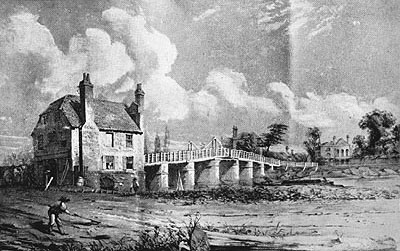
Datchet Bridge,
half in wood and half in iron, illustrated in 1847 by J Chapman.
The bridge was finally demolished in 1851.
|

